A Complete Goechala Trek Guide for all trekkers
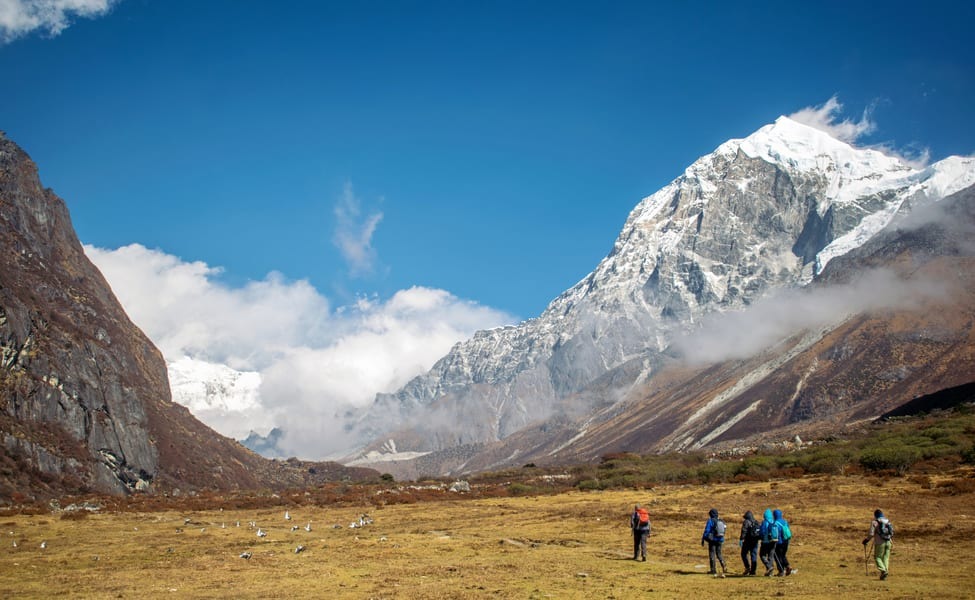
Quick Jumplinks to Navigate
The enchanting charisma of the North East offers the delight that is Goechala, a pleasing destination in the heart of Sikkim. With beautiful mounting summits with gargling streams meandering through expanses of meadows, Goechala Pass is an amazing trekking destination that is loved by travellers and trekking enthusiasts alike. This exhilarating trekking expedition takes you through the spine-tingling beauty of Sachen while pacing onwards towards Bhakim, Tshokha and Dzongri. The bewildering Dzongri Peak offers a stunning vision of the Kanchenjunga and Pandim Peaks while Goechala Pass will enchant you with its enrapturing mountain views from a majestic pinnacle of 16000 feet.
Enjoy a romantic and enchanting walk through forest regions, lush meadows and startling blue waters along the trail. Considered as one of the most romantic trekking trails in the country, get ready to be enchanted by the sensational mountains, the fascinating people, their distinctive culture and the mesmerizing trails that lead you to engage in a breath-taking experience. This Goechala trek guide will make your trekking more hassle free and a never forgettable experience.
Let us know how helpful this Goechala Trek Guide in the comments below!
Here is the complete Goechala trek guide for planning a perfect trekking expedition.
How To Reach
The Goechala Trek is an experience of a lifetime for anyone who wishes to explore the beautiful landscapes of the North East with an adventure packed thrill. This trek begins from NJP, which is easily accessible from air and rail. Although there are no airports here, your best access is to fly to Kolkata or Bagdogra; both have adequate flight options on a circadian basis. Once here, you can travel by railways to reach NJP. The North East Express Train or the Brahmaputra Mail transport passengers from Delhi. If you take a train from Kolkata, you can choose from various train systems such as Kamrup Express, Darjeeling Mail, Uttar Banga Express and the like. Once in NJP, you can reach the base camp of Yuksom easily by the allotted pick up vehicles.
Also Read: Best Himalayan Summer Treks that are inevitable.
Base Camp
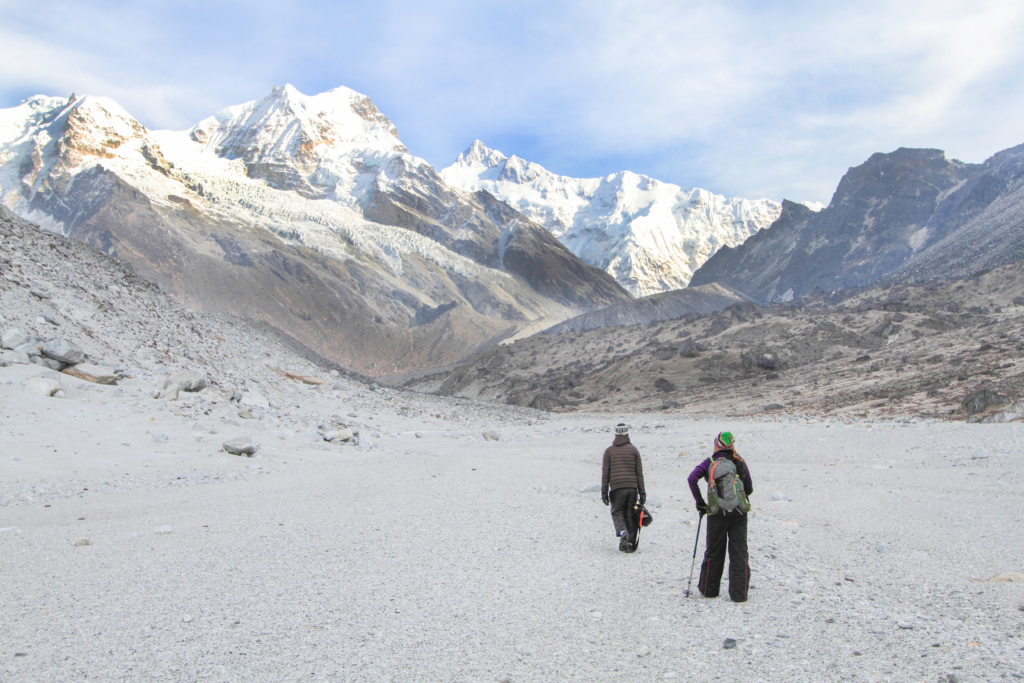
The Goechala Trek begins when you arrive in NJP, where you will be picked up and driven to the base camp of Yuksom. A large settlement, which was once the historical capital of Sikkim, Yuksom is a bustling hill station with stress-free hospitality and various cultural shows that forms the charm of the place.
Yuksom has such an impeccable beauty that is equally historical and unspoilt by tourism. Kickback a quiet night amidst nature as Yuksom’s charming serenity will take you on foot to explore and experience nature in its ingenuousness. It stands at a majestic elevation of 5670 feet and has few attractions such as the Kartok Lake and the Phamrong Waterfalls that you just can’t miss, given that time allows you such an indulgence.
Best Season To Visit
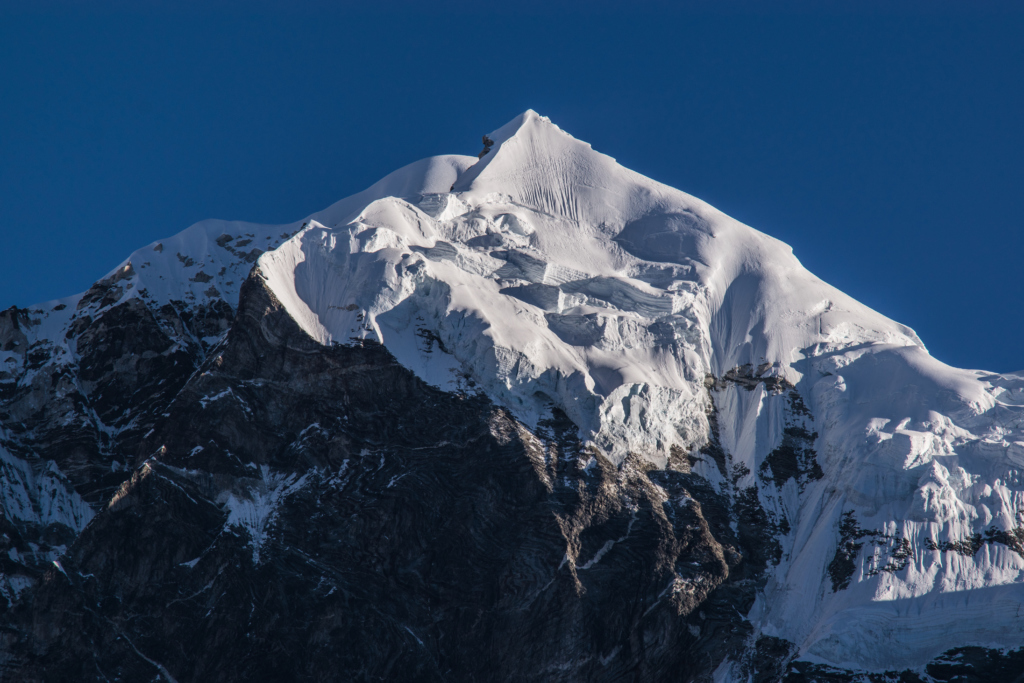
The Goechala Trek is an experience that can be sought by trekking enthusiasts all year round. This is what the charm of the meadows and valleys offer, a year-round indulgence for trekkers with any level of experience. Yet, we recommend that you undertake this expedition during autumn – the months of September to November or during summer -between March and June. Trekking during the monsoon season is strictly not recommended, as the stretches of trails tend to be slippery and muddy with chances of mudslides and rocks blocking the paths are highly common.
About The Locals
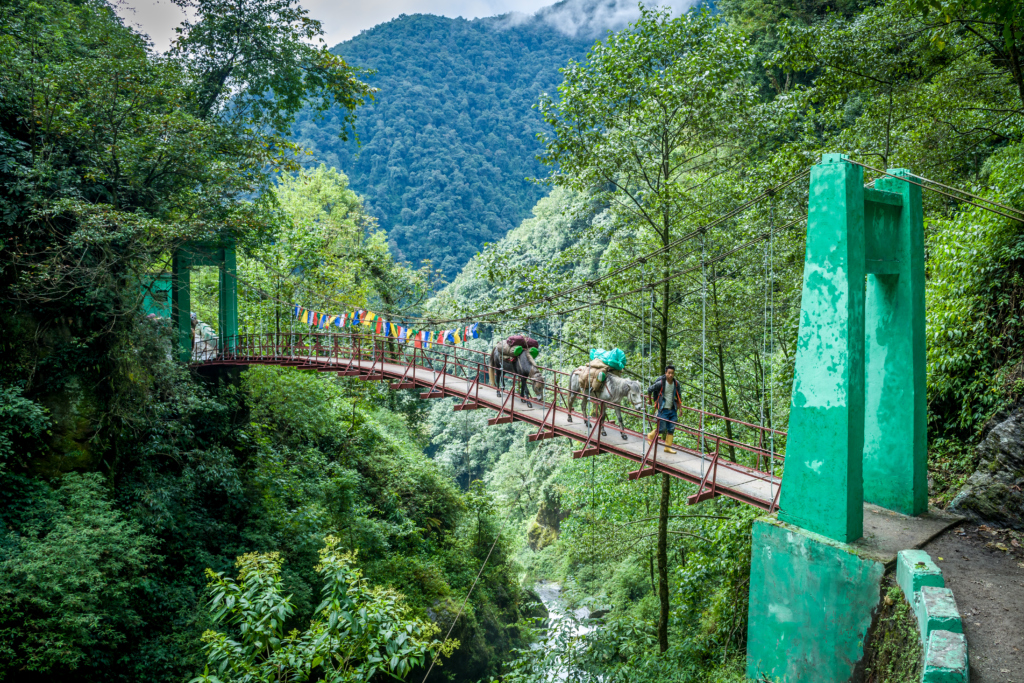
The people of Sikkim have a unique way of life and are largely influenced by the culture of Tibet and Buddhism. With a large number of Nepal descendants who have settled here since long, Sikkim also holds populaces of Lepchas, the original inhabitants of Sikkim and Bhutias, the migrators of Tibetan origin. Sikkimese people, as they are affectionately called, are warm, friendly and simple with an air of nature’s gaiety among them. With a love for celebrations, the locals engage in diverse ethnic and cultural activities. They find their expressions in the form of art, which can range from a beautifully carved ‘choktse’ or a bamboo artifact that one can carry back as a memento of their experiences.
Elevation Points
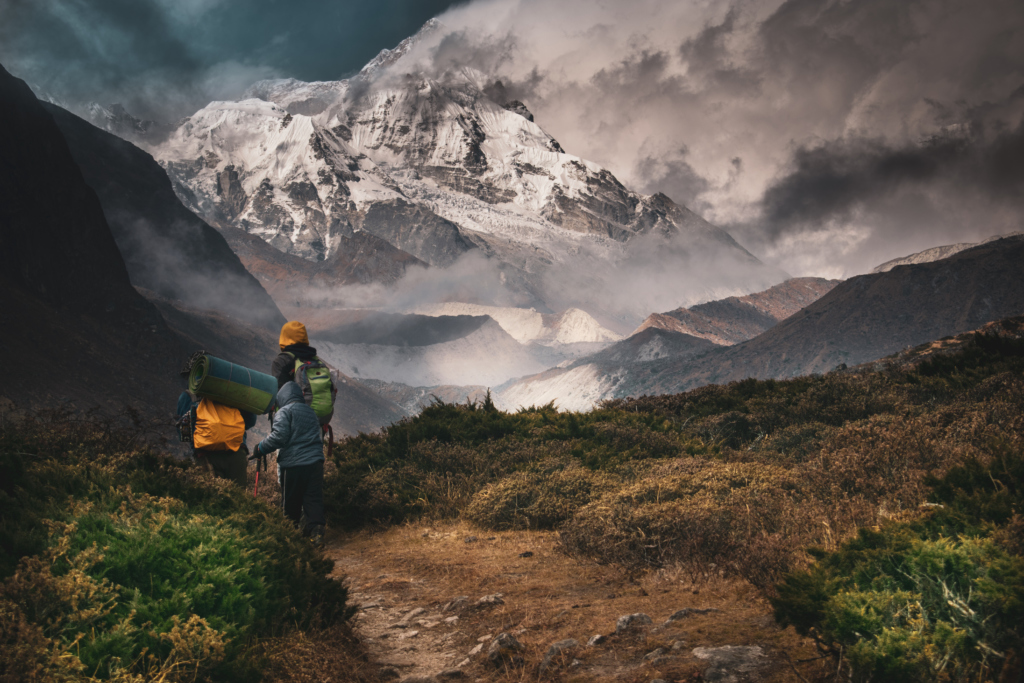
This spectacular trekking expedition takes you from the initial pickup point at NJP to the basecamp of Yuksom that lies at 5670 feet. A six-hour drive and an overnight stay later; you will begin your acclimatization trek to Sachen that stands tall at 7200 feet where the beautiful Mentogang River will leave you enthralled.
Ascend to the magical 9700 feet of Tshokha and visit a monastery amidst scenic meadows at Dzongri, which stands at an astounding height of 12980 feet. Once you get acclimatized here at this elevation, you will then proceed to the uppermost tip of Dzongri that stands at 13,675 feet before you slope down to Thansing at 12900 feet. The trekking trail spearheads you from Thansing to Lamuney, which touches the pinnacle of 13600 feet to take you ahead to the much-awaited Goechala at a spellbinding 16000 feet.
Permits
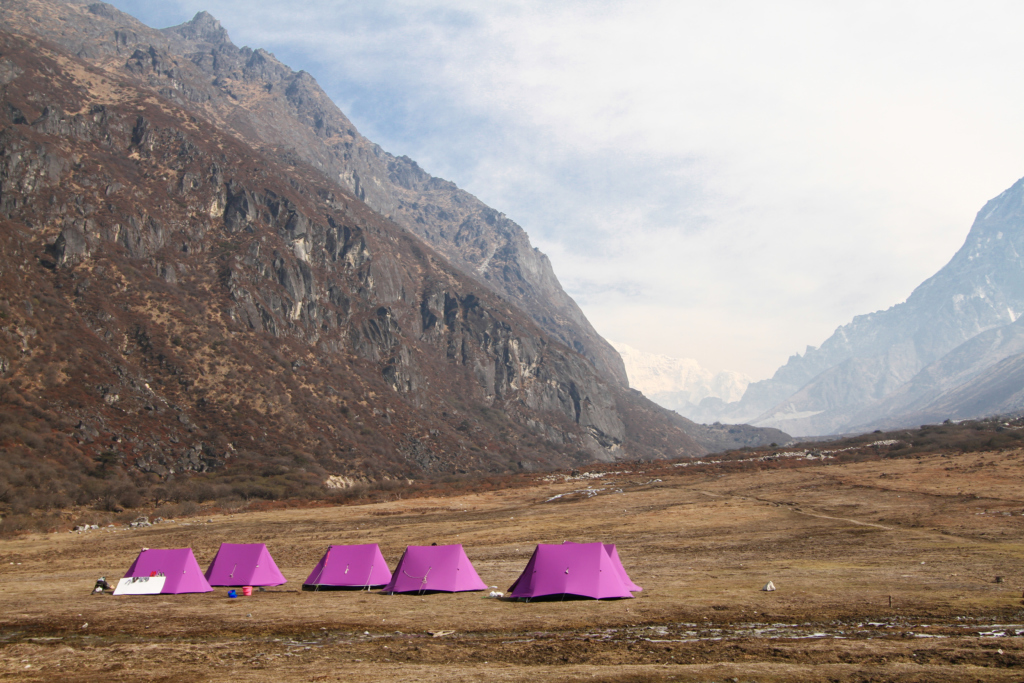
The required permits for the trek and camping charges for the trek may be included as part of the trekking expedition. Please carry your ID cards and photocopies of your driving license or voter ID or passport (along with visa for non-Indian travellers), along with passport size photos. A PAN Card is not accepted.
A medical certificate ensuring your fitness for the trek and a disclaimer certificate ensuring your submission to voluntarily participate in this trek is mandatory. The Adventure Cell of Sikkim Tourism & Civil Aviation Department issues permits that can be organized by trek operators. Solo travellers, Indian or Foreign Nationals are not permitted to visit protected areas, so please travel to these areas in groups of two or more. Restricted Area Permits (RAP) is mandatory for foreign travellers only.
Medical Advice and Emergency Numbers
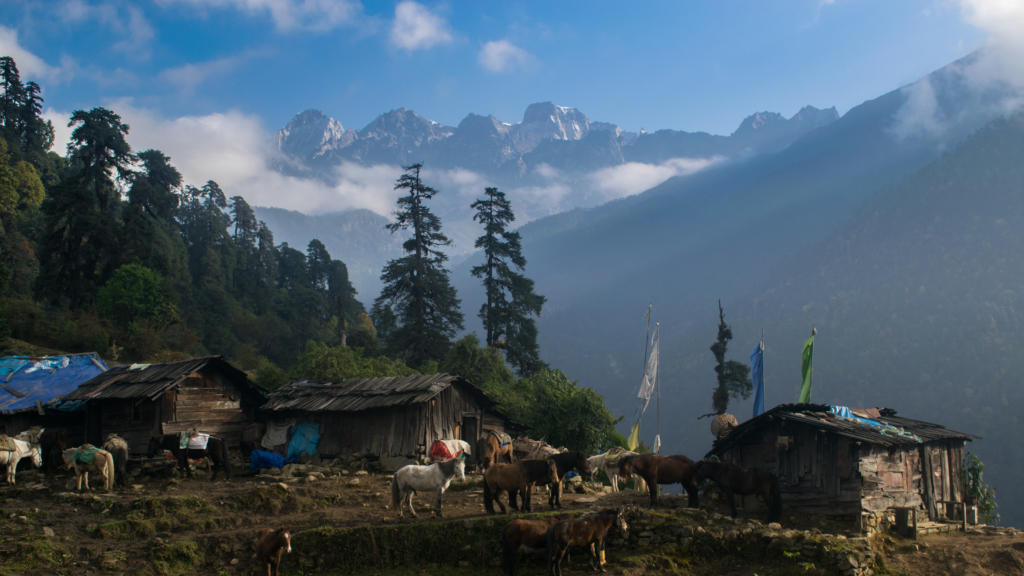
A well-equipped first aid kit will be accessible with the guides throughout the duration of the trek. We recommend that you carry your own individual resource of first aid items such as medicines, antiseptics, insect repellents, prescription drugs etc. All precautionary measures shall be taken to ensure your safety yet there lays no harm in having awareness of the general know-how of healthcare.
CPR and other common medical knowledge about altitude sickness (Acute Mountain Sickness) should be present. This illness is associated with trekking with symptoms that range from headache, insomnia, gastrointestinal issues, lung problems, ataxia etc.
Please consult your doctor before your trip to procure prescription drugs for such possible situations and only consume them if required, as they are powerful and have strong effects, especially if taken during your trek.As the Goechala Trek lies in the Gyazling Division of West Sikkim, please keep with you at all times the following emergency contact details.
Gyazling Ambulance: +91 3595 250823
Fire Brigade: +91 3595 250810
Electricity: +91 3595 250817
SIKKIM POLICE, WEST: SP – 953595 250763
SDPO/Gyazling: 250872/250873
Chief Medical Officer: +91 3595 250634
Gyazling Hospital: 250823
Tourism Information Centre, Delhi: 011-26115346, 011-26115171
Tourism Information Centre, Gangtok: 03592-209090
Advice and Expectations
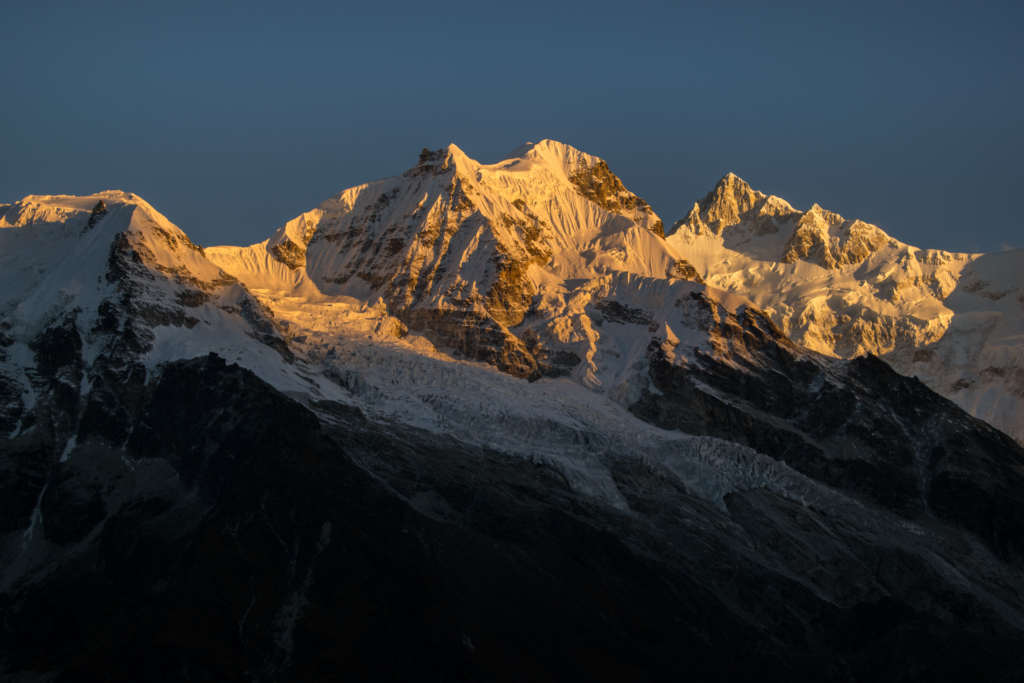
This expedition is the perfect experience to enjoy the thrill of the Himalayas yet it holds extremely harsh conditions and is generally considered to have a hard level of difficulty. Prepare thoroughly with regard to clothing and other protective gears to endure the unpredictable mountain weather, as it may get very cold. Keep your trekking gear safe and always keep essentials such as a wind-proof jacket, dry socks and caps at hand.
Make sure you choose correct and good quality footwear and fitted boots to avoid frostbites. Wear the right kind of socks to facilitate blood circulation. Carry a sturdy sleeping bag that is durable and comfortable. Carry a good quality backpack that can ensure harsh conditions of wear and tear, especially with a plastic or waterproof lining. Carry your identification proof as you might be expected to furnish it with the officials for obtaining permits.
Things To Carry
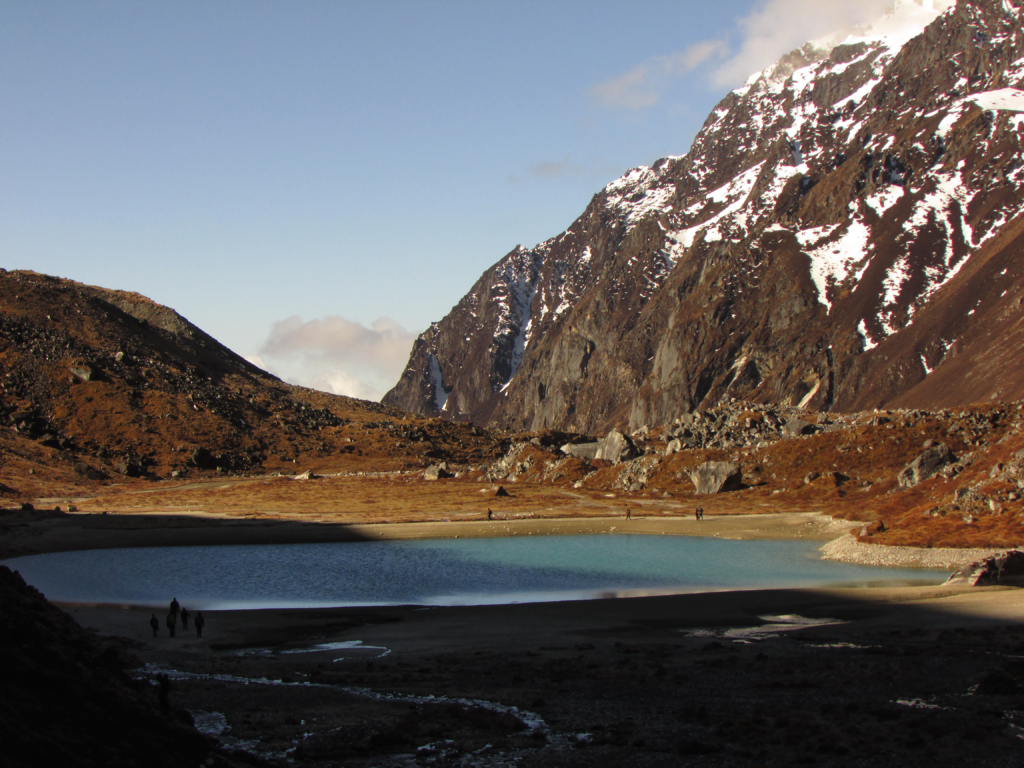
In this Goechala trek guide, we recommend you to carry these things for a perfect hassle-free trekking:
– Good condition trekking boots
– Camp shoes for crossing rivers and for visiting Devariyatal
– A pair of thick woolen socks never hurt when trekking in the Himalayas
– Keep a thick winter jacket for dealing with the cold
– Trekking Pants are a must for scaling the peaks
– Keep a woolen cap to protect yourself from the biting cold
– A pair of sunglasses to avoid the glaring sun
– Sun Screen
– A 2 ltr. water bottle
– Trekking pole
– A first aid box is a must-have on this trekKeep a swiss knife with you at all times.
Attractions
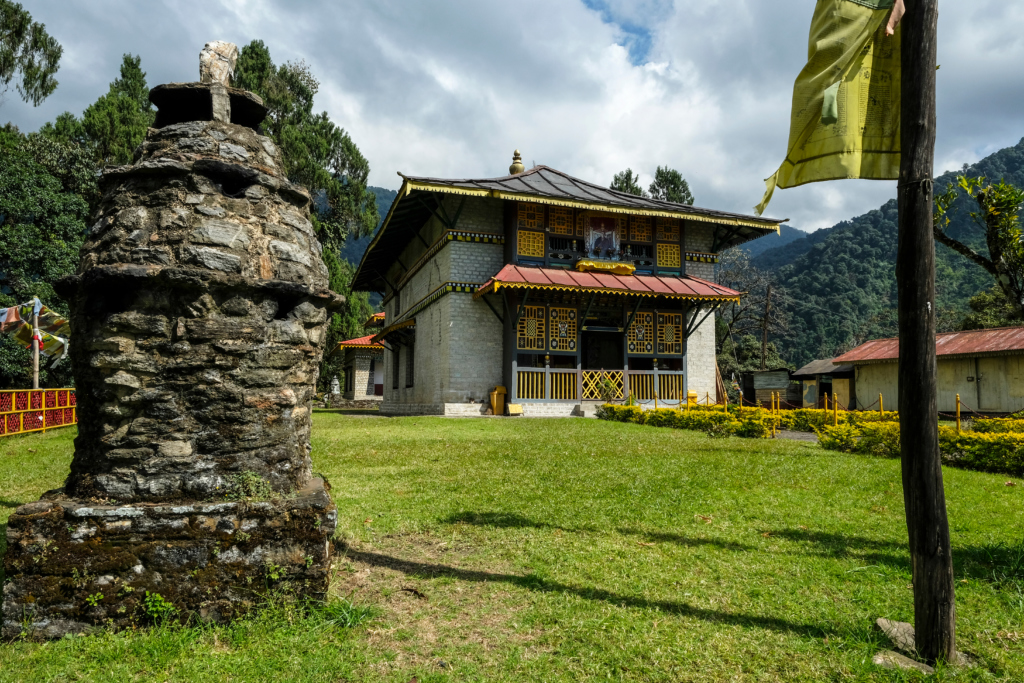
Yuksom – The first capital of the Sikkim Kingdom that handed over its title to Gangtok, Yuksom is the start of the spectacular Kanchendzonga trekking trail. Literally, Yuksom means ‘the meeting place of the three learned monks’, monks who selected Phuntsog Namgyal to be the first king with the title ‘Chogyal’ in 1642 AD. It falls under the Geyzing subdivision and is an ultimate tourist destination, visited by avid travellers and trekkers. Various monasteries surround it with the site of the coronation throne of the ancient kingdom, which can still be witnessed here. Surrounded by abundant greenery, Yuksom sits amidst pristine lakes and spectacular hills.
Sachen – An unexplored situate filled with dense forests, Sachen has limited resources and little development in terms of accommodation or other facilities. It is accessible by trekking from the town of Yuksom through green meadows that lie alongside the Rathong River. With several acres of forest areas surpassing Mentogang River, Sachen lies at the pinnacle of 7200 feet. An array of beautiful log huts can be seen lining below the trails here with the gushing waters of the Perk waterfall that lullabies throughout the meadows.
Tshokha – Tshokha is a small hamlet that stands curtailed with limited houses floating on the edge across a valley that drops down from the other three sides. It is the only settlement that stands thriving in the Kanchenjunga National Park region. With thick impenetrable forests ornamenting the trekking trails, Tshokha offers bushy shrubbery with vertical gradients and an unusual profusion of leeches. It is home to numerous Himalayan birds and is one of the hotspots of bio-diversity in the world.
Dzongri – With mystical valleys adorned by vibrant gorges amidst flower cossets, Dzongri offers an impeccable vision of the breath-taking Kanchenjunga, the third highest peak in the world. Dzongri is popularly known as ‘the meeting place of men and mountains, of god and nature’. Various trekker huts line this region, as it is an admired campsite for trekkers. One can catch the spectacular glimpse of Rhododendron blooms spread across acres of meadows on the log trail that leads to Dzongri. The viewpoint here at the Dzongri Top stands at 13675 feet with Tibetan prayer flags adorning the views of the peaks of Kanchenjunga, Kabru, and Pandim.
Thansing – A beautiful valley that stands at a majestic elevation of 12900 feet, the trail to Thansing is layered with abundant meadows at the base of the Jopine ranges. It is lined by a few chortens, or Buddhist worship spots, that is a perfectly framed within the backdrops of the snow covered Pandim and Kanchenjunga Peaks. Thamsing is a pristine meadow perched on a slope of the Mount Pandim.
Lamuney – Across mountains and ridges, alongside picturesque meadows and green grasslands, Lamuney is the campsite that offers the pristine attraction of Lake Samiti. This lake offers crystal clear blue green water that is setup so perfectly with the backdrops of mountains that you will be mesmerized by its natural genesis. With changes in the sunlight and cloud passages, the enchanting change in the landscapes of snow must be witnessed. It is considered a holy lake by the Sikkimese and holds various rocky areas filled with boulders.
Goechala – Beautiful mounting summits with bubbling water streams that flow through expanse of green meadows is just the ultimate way to describe Goechala. The Goechala Pass is the highest point of the trekking trip with an astounding elevation of 16000 feet. The trail leading to Goechala is filled with glacial moraines; a frozen lake covered with snow and of course, the gigantic peaks of Kabru, Pandim and Kanchenjunga. With slops of snow that resemble skiing fields, Goechala is the eventual destination of this mystifying trekking expedition.
Itinerary
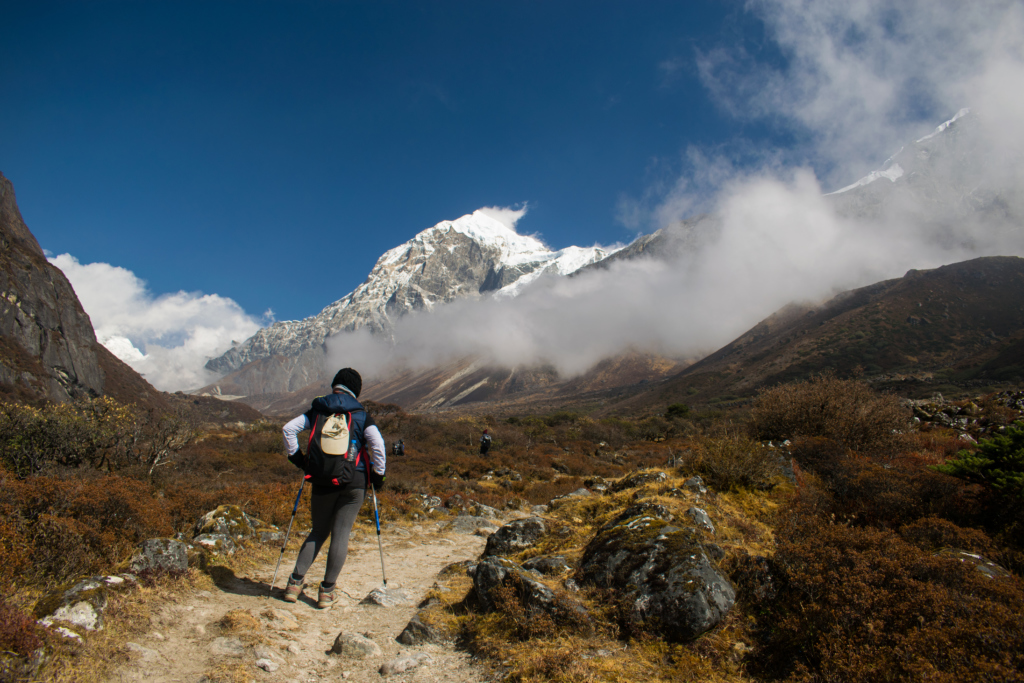
Day 01: Drive from NJP to Yuksom (5,670 feet)
Day 02: Trek from Yuksom to Sachen (7,150 feet)
Day 03: Trek from Sachen to Tshokha (9,700 feet)
Day 04: Trek from Tshokha to Dzongri (12,980 feet)
Day 05: Acclimatization day at Dzongri
Day 06: Trek from Dzongri – Dzongri Top (13,675 feet) – Thansing (12,900 feet) via Kokchurang (12,000 feet)
Day 07: Trek from Thansing to Lamuney (13,600 feet)
Day 08: Trek from Lamuney (13,600 feet) – Goechala (16,000 feet) – Thansing; via Samiti Lake (14,100 feet)
Day 09: Trek from Thansing to Tshokha (via Phedang)
Day 10: Trek from Tshokha to Yuksom; via Bhakim and Sachen
Day 11: Departure from Yuksom; Arrival in NJP
Tips And Tricks
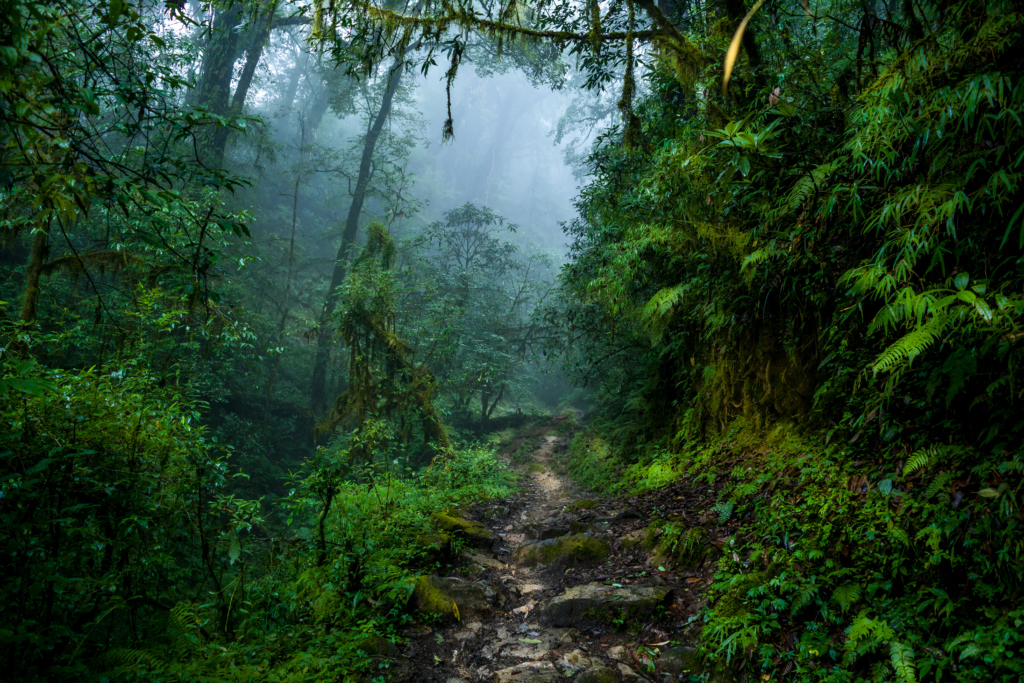
– Hydrate your body two days prior to the trek, which means you must triple your water intake to avoid Dehydration.
– Choose a SHOE SIZE HALF A NUMBER BIGGER THAN YOUR NORMAL NUMBER. It would be really uncomfortable if one chooses a shoe size which is one number smaller than their actual shoe size. One can end up with sore fingers and blisters at the end of trek. To avoid BLISTERS, one can wear double socks – wear a thin nylon one first and then wear a thick Turkish sock which will definitely prevent blisters.
– In case you are carrying your Camera or Mobile phone with you, make sure you carry enough supply of plastic waterproof bags.
– Once you start trekking along with the entire group, try and get your NATURAL RHYTHM of walking. Never attempt to walk too fast or too slow as this can lead to premature fatigue.
– It is advisable to carry a WINDCHEATER but it is not advisable to wear it while trekking. During trekking, our body produces solid heat and to regulate that, the heated muscles of our body sweats profusely. In a humid atmosphere, it is a hot and perspiring situation and we aggravate it by wearing windcheaters. All in all, it leads to a suffocated feeling, so our advice is to keep a windcheater in your sack and wear it only when you take a long halt
Was this Goechala Trek Guide helpful? Let us know how you feel about this in the comments.
How is the weather on Goecha La trek?
The weather in Goecha La trek stays quite cold and wintery throughout the whole year. Besides, this beautiful location also experiences a mild amount of snowfall during the months of November and December.
Thus, according to the Goechala Trek Guide, the season of summer is considered to be the best time to visit this amazing location. During this period, the sky here stays quite clear and you will not be able to see any signs of rainfall as well.
So, if you are considering travelling to the place for sightseeing and trekking, then summer would be the best time to visit for you.
What will be the distance covered each day on Goechala Trek?
While hiking through the trails of the aesthetic Goechala Trek, you will need to cover around 8km to 9km of distance on a regular basis as it is a 90km trek. Otherwise, it will be almost impossible for you to complete the whole trek within 10-11 days.
Besides, the trail of the trek is filled with various natural obstacles, thus, if you are coming here for the first time, then be sure to opt for a Goechala Trek Guide.
What all I must pack for the Goechala Trek?
To prepare yourself for the hardships of the Goechala trek, you will need to pack up the following things alongside the Goechala Trek Guide –
- The fundamental set of gear for trekking
- A trekking pole, at least two refillable water bottles, and a durable rucksack
- Trekking pole, torch, and some spare batteries
- Sunscreen lotion, moisturizers, cold cream, toilet roll, small towel, and other much-needed toiletries
- A bottle of sanitiser
- First-aid kit and prescribed medicines (if required)
- Some dry fruits, chocolates, and energy bars
- Quick-dry clothing item, gloves, padded jacket, warm shirts, hiking slippers and shoes
How difficult is Goecha La Trek?
Goecha La Trek is a moderate to difficult trek. Due to the trekking distance of around 90km, it takes about 10-11 days of trekking on high altitudes. However, if you have hired a Goechala Trek Guide, then you can also have an amazing trekking experience here as a beginner.
How much is the Goecha La Trek distance?
The overall trekking distance of the beautiful Goecha La Trek is around 90 km as a whole. Therefore, it will take you almost around 11 to 12 days to reach the finishing line of the same. However, once you have reached your destination, the whole view will surely mesmerize you and your travel partners.
What is the best time to go for Goecha La Trek?
The best time to have a trekking experience in the famous Goecha La Trek is, indeed, summer. During this period, the weather in this location stays quite warm and pleasant.
Besides, you would also not have to worry about being drenched to your core due to rainfall during this season. However, several animals tend to come out of their shell during summer for various reasons. So, you might see a lot of them while on your way to the top of Goecha La.
